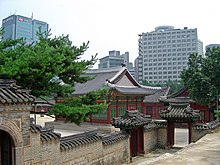
Back قصر دوكسو Arabic Doqsuqunq Azerbaijani کۆشکی دیۆکسوگونگ CKB Deoksugung German Deoksugung Spanish دیوکسو گونگ Persian Deoksugung French Tokszugung Hungarian Թոքսուգուն Armenian Istana Deoksu ID
| Deoksugung | |
|---|---|
 View of the palace in 2011 | |
 | |
| General information | |
| Type | Royal palace (former) |
| Town or city | Jung-gu, Seoul |
| Country | South Korea |
| Coordinates | 37°33′58″N 126°58′29″E / 37.56618°N 126.97485°E |
| Website | |
| www | |
| Deoksugung | |
| Hangul | 덕수궁 |
|---|---|
| Hanja | |
| Revised Romanization | Deoksugung |
| McCune–Reischauer | Tŏksugung |


Deoksugung (Korean: 덕수궁) also known as Gyeongun-gung, Deoksugung Palace, or Deoksu Palace, is a walled compound of palaces in Seoul that was inhabited by members of Korea's royal family during the Joseon monarchy until the annexation of Korea by Japan in 1910. It is one of the "Five Grand Palaces" built by the kings of the Joseon dynasty[1] and designated as a Historic Site.[2] The buildings are of varying styles, including some of natural cryptomeria wood[citation needed]), painted wood, and stucco. Some buildings were built of stone to replicate western palatial structures.
In addition to the traditional palace buildings, there are also forested gardens, a statue of King Sejong the Great and the National Museum of Art, which holds special exhibitions. The palace is located near City Hall Station.
Deoksugung, like the other "Five Grand Palaces" in Seoul, was heavily damaged during the colonial period of Korea. Currently, only one third of the structures that were standing before the occupation remain.[3]
Deoksugung Palace is special among Korean palaces. It has a modern and a western style garden and fountain. The Changing of the Royal Guard, in front of Daehanmun (Gate), is a very popular event for many visitors. The royal guard was responsible for opening and closing the palace gate during the Joseon dynasty. Outside of the palace is a picturesque road with a stone wall.[4]
The Deoksugung Stonewall walkway is at the heart of a popular urban myth in Seoul, as it is said that all couples who walk down this road are fated to break-up.[5]
- ^ "The 5 Palaces of Seoul". The Chosun Ilbo. 24 January 2012. Retrieved 23 April 2012.
- ^ Cite error: The named reference
VKwas invoked but never defined (see the help page). - ^ "일제에 의해 훼손된 옛 덕수궁 터이번엔 미대사관 신축부지로 전락". OhmyNews. 12 March 2002.
- ^ "Deoksugung Palace". Visit Seoul. Archived from the original on 29 November 2014. Retrieved 16 November 2014.
- ^ "Top 5 Places to Visit in Seoul with Korean Superstitions". english.visitseoul.net. Retrieved 2021-04-01.
© MMXXIII Rich X Search. We shall prevail. All rights reserved. Rich X Search